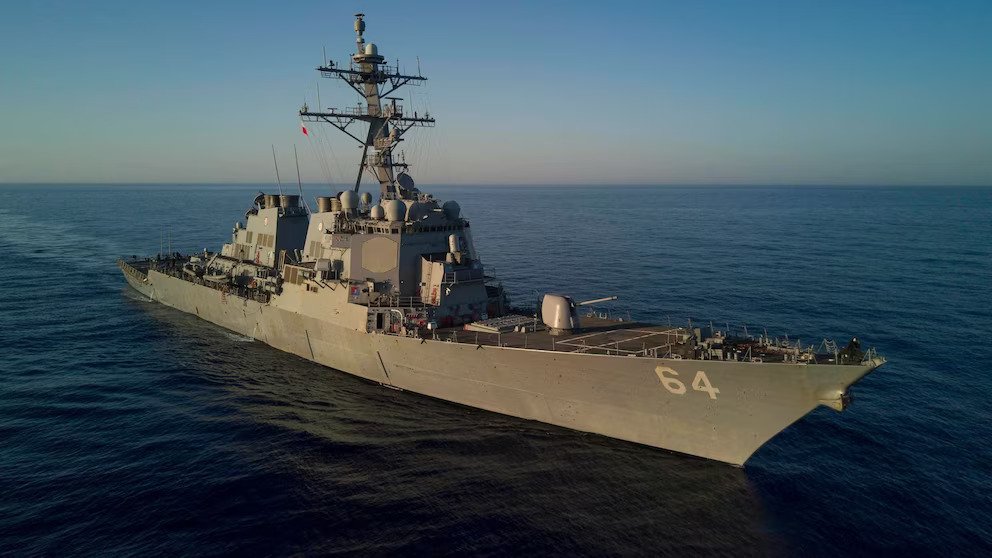The USS Carney, a U.S. Navy guided-missile destroyer, stationed in the northern Red Sea, achieved a significant milestone on Thursday when it successfully intercepted multiple missiles and drones launched by Iranian-backed Houthi rebels in Yemen. These projectiles, believed to be potentially targeting locations in Israel, posed a unique challenge as they were not directly aimed at the U.S. Navy vessel.
This incident marked the first time in recent memory that a U.S. Navy ship in the Middle East engaged missiles and drones not directed at the ship itself. Furthermore, it represented the initial U.S. military action taken to defend Israel amid the ongoing crisis. As the U.S. and other nations sought to manage the conflict between Israel and Hamas, the involvement of an Iranian-backed proxy group in launching missiles and drones at Israel added to the already escalating regional tensions.
The USS Carney was positioned in the northern Red Sea when it intercepted three land attack cruise missiles and multiple drones, as reported by Pentagon spokesman Brig. Gen. Pat Ryder during a press briefing. Preliminary assessments indicated that the USS Carney was not the intended target of the Houthi missiles and drones, although the specific targets of these projectiles remained uncertain as information was still being processed.
While the exact launch location of the Houthi militia’s missiles remains unclear, their trajectory indicated a northward direction. The Houthi rebels, who are backed by Iran, have seized control of a significant portion of northern Yemen and have been engaged in a prolonged conflict with a Saudi-led coalition since 2015. However, the missiles intercepted on this occasion did not appear to be aimed at targets within Saudi Arabia.
Notably, Houthi leader Abdel-Malek al-Houthi had previously stated that his group would respond to direct U.S. intervention in the Gaza conflict by launching drones and missiles, among other military options.
The incident occurred during the early evening hours, local time, as the missiles and drones were detected moving northward over the waters of the Red Sea. The USS Carney successfully engaged the Houthi-launched missiles using SM2 missiles, though details about how the eight drones were brought down were not disclosed.
Brig. Gen. Ryder clarified that the intercepts occurred over water, and no harm was reported to U.S. sailors aboard the ship.
In response to the escalating situation in the region, the United States had increased its military presence, including the deployment of the USS Gerald R. Ford carrier strike group to the eastern Mediterranean, with the aim of deterring Iran and Hezbollah from entering the Israel-Hamas conflict. To further enhance deterrence and regional stability, the USS Dwight D. Eisenhower carrier strike group was en route to the eastern Mediterranean.
The U.S. intended to signal its commitment to safeguarding national security interests by deploying naval assets and advanced fighter aircraft in the region, as confirmed by Brig. Gen. Ryder.
The USS Carney had recently transited through the Suez Canal and was stationed in the northern Red Sea at the time of the missile interception. This successful engagement contributed to regional deterrence efforts and highlighted the seriousness of the U.S. military presence.
The risk to U.S. forces and interests in the region had risen, particularly following a deadly explosion at a hospital in Gaza, which further inflamed regional tensions. There were incidents involving drones near U.S. bases in Iraq and eastern Syria, and one U.S. contractor in Iraq had tragically passed away due to cardiac arrest during an incident.
The USS Carney’s interception of Houthi missiles raised the possibility of potentially positioning more U.S. Navy ships in the Red Sea to protect against potential attacks on Israel from the south, according to Steve Ganyard, an ABC News contributor and former Pentagon official. The broader concern was whether Iran might view U.S. ships as fair targets, although there was no known reason to believe that Iran desired a confrontation with the U.S. and Israel, and hopes were for a de-escalation of tensions.
This significant event involving the USS Carney in the northern Red Sea underscores the complex dynamics of the Middle East and the challenges faced by U.S. military forces in the region. In this comprehensive discussion, we will explore the details of the incident, its implications, and the broader context of regional tensions and conflicts.
On a Thursday in the northern Red Sea, the USS Carney, a U.S. Navy guided-missile destroyer, found itself at the center of a critical engagement. Iranian-backed Houthi rebels in Yemen had launched a barrage of missiles and drones that were potentially headed towards targets in Israel. The Pentagon swiftly reported this incident, recognizing its gravity. The USS Carney’s successful interception marked a pivotal moment in U.S. Navy operations, as it was the first time in recent memory that a U.S. Navy ship in the Middle East had engaged missiles and drones that were not directly aimed at the vessel itself.
The situation became even more significant due to the fact that it was the first U.S. military action taken to defend Israel during the current crisis. With the U.S. and other countries working to contain the conflict between Israel and Hamas, the involvement of an Iranian-backed proxy group in launching missiles and drones at Israel added to the already mounting regional tensions.
The USS Carney was strategically positioned in the northern Red Sea when the incident unfolded. The destroyer intercepted three land attack cruise missiles and several drones. Pentagon spokesman Brig. Gen. Pat Ryder provided this information during a press briefing. Notably, the USS Carney successfully brought down eight drones launched by the Houthi rebels. However, at that point, there was still considerable uncertainty about the exact targets of these missiles and drones, as the information was being processed.
It’s important to note that the USS Carney itself was not the intended target of the Houthi missiles and drones, according to multiple U.S. officials. This incident raised questions about the nature of the intended targets, although it was clear that these projectiles had been launched from Yemen, heading north along the Red Sea, with potential destinations in Israel.
The launch location of the Houthi missiles remained uncertain, but their trajectory was indicative of a northward direction. The Houthi rebels, who receive support from Iran, had taken control of a significant part of northern Yemen and had been engaged in a prolonged conflict with a Saudi-led coalition since 2015. However, the missiles intercepted on this occasion did not appear to be aimed at targets within Saudi Arabia.
A notable development leading up to this incident was a statement made by Houthi leader Abdel-Malek al-Houthi. He had warned that if the U.S. directly intervened in the Gaza conflict, his group would respond by firing drones and missiles, along with other military options. This threat added an extra layer of complexity to the situation and increased the stakes.
The engagement itself took place during the early evening hours, local time, as the missiles and drones were detected moving northward above the waters of the Red Sea. The missiles fired by the Houthi rebels were engaged by SM2 missiles carried aboard the USS Carney, as revealed by a U.S. official. However, details about the specific weapons platform used to bring down the eight drones were not disclosed.
Brig. Gen. Ryder clarified that the intercepts had occurred over water, and no harm was reported to U.S. sailors aboard the ship, indicating the success of the operation in protecting the vessel and its crew.
In response to the escalating situation in the region, the United States had significantly bolstered its military presence. This included the deployment of the USS Gerald R. Ford carrier strike group to the eastern Mediterranean, with the primary aim of deterring Iran and Hezbollah from becoming involved in the Israel-Hamas conflict. Defense Secretary Lloyd Austin had recently extended the deployment of the Ford strike group to maintain its presence in the eastern Mediterranean. Additionally, he ordered the deployment of additional fighter aircraft to U.S. airbases in the region to further enhance deterrence.
The U.S. intended to signal its strong commitment to safeguarding its national security interests by positioning naval assets and advanced fighter aircraft in the region. This move was seen as an effort to deter a wider conflict, bolster regional stability, and make it clear that the United States would protect and defend its national security interests. Brig. Gen. Ryder underlined these intentions in his statements to the press.
The USS Carney had recently transited through the Suez Canal and was stationed in the northern Red Sea when it successfully intercepted the Houthi missiles and drones. This engagement showcased the readiness and capability of U.S. naval assets to respond to threats and contributed to regional deterrence efforts.
The risk to U.S. forces and interests in the region had escalated, particularly following a tragic incident where a hospital in Gaza was struck by an explosion, leading to further inflamed regional tensions. In the days leading up to the USS Carney’s interception, there were incidents involving drones near U.S. bases in Iraq, and another drone was shot down near U.S. forces in eastern Syria. Tragically, one U.S. contractor, sheltering in place at one of the bases in Iraq, had died of a cardiac arrest during one of these incidents. Additionally, Al Asad airbase in western Iraq experienced indirect fire, according to a U.S. official.
The USS Carney’s successful interception of Houthi missiles raised the possibility of the U.S. Navy having to position more ships in the Red Sea if the U.S. committed to protecting Israel from a potential southern attack. This scenario was discussed by Steve Ganyard, an ABC News contributor and a former Pentagon official. The larger concern was whether Iran might now consider U.S. ships as fair game. Ganyard pointed out that if the Houthis had indeed shot at a U.S. ship, there would be little doubt that it would have been at Tehran’s direction. However, there was no known reason to believe that Iran desired a confrontation with the U.S. and Israel, and hopes were for a de-escalation of tensions in the region.
In conclusion, the interception of Houthi missiles and drones by the USS Carney in the northern Red Sea was a significant event with far-reaching implications. This incident highlighted the complexity of the Middle East’s geopolitical landscape and the challenges faced by U.S. military forces stationed in the region. As the situation continued to evolve, the world watched closely, hoping for a peaceful resolution to the regional tensions and conflicts.





